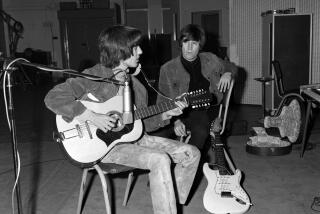BOOK REVIEW : Electrically Charged : Author Amplifies Role of O.C.’s Fender and the Sound ‘Heard ‘Round the World’
- Share via
The genesis of any revolution can be difficult, if not impossible, to ferret out. Precisely when and where did the idea first blossom among colonists in the New World to try to form a more perfect union? Who knows?
Fortunately, author Richard Smith has quite nicely pinned down the roots of the most significant revolution ever born in Orange County, one that ushered in the rock ‘n’ roll era and forever altered the sound and style of popular music.
In his book “Fender--The Sound Heard ‘Round the World” (Garfish Publishing, $50), Smith quotes electric guitar innovator Leo Fender on getting the bug to tinker with electronic equipment for musicians during a trip in 1922, from his lifelong home in Orange County to visit an uncle’s auto-electric shop in Santa Maria.
“He had built some radio equipment and had a large wooden trumpet speaker in front of his shop, pointed downtown to [amplify] radio programs,” Fender reminisced years later in a high-school reunion speech cited by Smith.
“This acquainted me with radio and led to my building amplifiers for musicians,” Fender said. “Amplifiers led to electric guitars and their repair and design and to the Fender Guitar and G&L; guitars,” a reference to the latter-day guitar company where Fender continued working until the day before his death in 1991.
At first glance, the large-format size of this book may suggest just another coffee-table tome, full of photos, signifying little.
Don’t be fooled.
Fullerton resident Smith is a musician and historian who has written extensively about Fender and other guitar makers for Guitar Player, Guitar World and other magazines, and who wrote “The History of Rickenbacker Guitars,” another book on another legendary O.C.-based guitar-maker. He also is an avid guitar collector and pop music fan.
Much of the wealth of raw material that went into this book was on display in the Fullerton Museum Center’s 1994 exhibition on Fender, which Smith curated.
Assembled here in book form, it’s an astounding job of research, reportage, distillation and writing on a subject whose impact on music and society in general is inestimable. Some have credited Fender for helping to make possible the fall of the Berlin Wall and the collapse of Communism itself.
Such credit is not unjust: With Fender’s Telecaster and Stratocaster guitars and his amplifiers, the rock-band format as we know it was born, and that equipment, in the right hands, gave musical testament to the power of free expression. Western rock music inspired many a freedom-starved subject of a Communist regime to seek a better life, whatever the cost.
Such talk, however, would have been lost on Leo Fender himself. I recall attending his funeral service in Fullerton and hearing the praises heaped on him by musicians who attended. Then his widow, Phyllis, stood up and remarked that Leo, if he’d been listening in, wouldn’t have known who they were talking about, for all he ever wanted to do was sit at his workbench trying to make a better guitar pickup or amplifier circuit.
That kind of humility comes through in Smith’s book loud and clear, like the sounds from Fender amplifiers. But far from putting together a simple fan’s eulogy, Smith has compiled a full picture of a fascinating, multifaceted individual. The Leo Fender who emerges is not so much an Einstein-like genius as a latter-day Thomas Edison, a man who could recognize a need when he saw it and an improvement waiting to be made.
“It isn’t a radically different thing that becomes a success,” Fender once said. “It is the thing that offers an improvement on an already proven item.”
Fender didn’t invent the solid-body electric guitar--he simply made the first one that was practical to mass-produce and, hence, was commercially successful. He figured out what musicians needed not by intuition, but by talking to them. He frequented local bars, nightclubs and concert halls, often chatting with musicians, even showing up with a new prototype in hand and inviting them to give it a try on the spot.
He also had either the good luck or the good sense to hire Don Randall to sell the instruments he cooked up in his lab.
Less known outside guitar circles is the inestimable role that Randall, along with some early Fender salesmen such as Charlie Hayes and David Driver, played in getting the Fender name known and respected by musicians and retailers around the country.
Without them--and plant manager Forrest White, who made the Fender operation a model of efficiency--Fender very easily could have remained a talented but unknown tinkerer working in an anonymous workshop, rather than namesake of a company that went on to produce the most copied guitars in the world. Smith gives these men their considerable due.
He also quietly points out how significant geography was in the Fender story. If Leo had been working in South Dakota, say, or Minnesota, he’d have been far less likely after a day of work to stroll into a Mexican restaurant like the one in Placentia where one night he watched a member of a mariachi band plunking on the giant guitarron, a bass-voiced instrument worn around the neck like a regular guitar.
That gave him ideas that he parlayed into the Fender Precision Bass, which brought the bass out of the musical background and vaulted it into a fundamental position in rock, jazz, country and blues bands everywhere.
The major historical points all are here, from the introduction of Fender’s early steel guitars to the first solid-body standard guitars--the Esquire, the Broadcaster and the still-standard Telecaster and Stratocaster. The fascinating minutiae is here, too, such as Fender’s ill-fated 12-string electric guitar, which never supplanted the Rickenbackers made famous by the Beatles and the Byrds. Yet, Smith points out: “The Fender 12-string does have one distinction worth noting. Led Zeppelin’s Jimmy Page played one on the original recording of ‘Stairway to Heaven.’ ”
For the general reader who doesn’t know an Alnico pickup from a plugged nickel (I include myself in this category), the book’s exhaustive detail about the technological side of Fender’s designs can slow the reading at times. Smith notes, for instance, that the earliest Telecasters can be dated fairly precisely depending on whether they use standard-slot or Philips-head screws.
On the other hand, such information represents the difference between fool’s gold and the mother lode to guitar collectors who are always on the prowl for that lost six-stringed treasure, and to whom this volume might serve as a coveted treasure map.
The research also pays off in correcting Fender’s own sometimes faulty, sometimes just plain willful memory.
In many ways, Fender considered all his guitars to be part of one long-ongoing refinement process. So to him, it was irrelevant what year the first Telecaster appeared or exactly when he started to develop the Stratocaster.
Smith includes reproductions of the patent applications, complete with sketches, for most of Fender’s major designs, appendixes listing all the patents, a chart showing features and modifications for all Fender amplifier models made before the company was sold in 1965 to CBS (see accompanying story) and other such details.
Meanwhile, he elucidates how Fender’s equipment helped musicians realize new sounds that were in their heads--and even led them to discover sounds they’d never thought of.
Sorting through the dizzying array of often conflicting documents and interviews surely must have been an imposing task. It’s hard to imagine how anyone could have done better, with more accuracy or more affection, than Smith has--an attention to detail, perhaps, he picked up from Leo Fender.
More to Read
The biggest entertainment stories
Get our big stories about Hollywood, film, television, music, arts, culture and more right in your inbox as soon as they publish.
You may occasionally receive promotional content from the Los Angeles Times.










